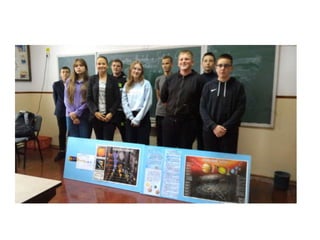Small and large through the Universe (1).pptx
- 1. Small and large through the Universe http://astro-urseanu.ro/descopera-universul/#jp-carousel-1615
- 2. Enriching Curricula with STEAM Implementations
- 3. The Milky Way Galaxy https://ro.wikipedia.org/wiki/Calea_Lactee
- 5. An image of the galaxy UGC 12158, believed to resemble the Milky Way, taken by the Hubble Space Telescope. https://upload.wikimedia.org/wikipedia/commons/b/b3/UGC_12158.jpg
- 6. Representation of the solar system in which the plane of the Earth's orbit around the Sun can be seen in 3D. Mercury, Venus, Earth, and Mars are shown in both images; the one on the right represents a full revolution of the planet Jupiter, while Saturn and Uranus make less than a full revolution. https://upload.wikimedia.org/wikipedia/commons/0/0d/Ecliptic_plane_3d_view.gif https://ro.wikipedia.org/wiki/Fi%C8%99ier:Solarsystem3DJupiter.gif
- 7. The distance of bodies in the solar system from the Sun. The left and right edges of each bar correspond to the respective body's perihelion and aphelion. Long bars denote high orbital eccentricity. https://ro.wikipedia.org/wiki/Sistemul_solar
- 8. Inner planets. From left to right: Mercury, Venus, Earth and Mars in original colors, with dimensions to scale (except for distances between planets). https://ro.wikipedia.org/wiki/Sistemul_solar#/media/Fi%C8%99ier:4_Terrestrial_Pla nets_Size_Comp_True_Color.png
- 9. Image representing the asteroid belt (in white), Jupiter's Trojans (in green), the Hilda family (in orange), and near-Earth asteroids. https://ro.wikipedia.org/wiki/Sistemul_solar#/media/Fi%C8%99ier:InnerSolarSystem-en.png
- 10. From top to bottom: Neptune, Uranus, Saturn and Jupiter (Montage with colors and approximate sizes) https://ro.wikipedia.org/wiki/Sistemul_solar
- 11. Hale-Bopp was discovered on July 23, 1995, at a great distance from the Sun, raising hopes that it will become much brighter as it approaches the Sun and Earth. Although forecasting the brightness of comets is a difficult art, Hale-Bopp met or exceeded predictions when it passed perihelion on April 1, 1997. It is thus aptly named "The Great Comet of 1997." https://ro.wikipedia.org/wiki/Sistemul_solar#/media/Fi%C8%99ier:Comet_c1995o1.jpg
- 12. An artist's rendering of the Oort cloud, Hill cloud, and Kuiper belt https://ro.wikipedia.org/wiki/Sistemul_solar#/media/Fi%C8%99ier:Kuiper_belt_- _Oort_cloud-en.svg
- 13. A diagram of Earth’s location in the Universe in a series of eight maps that show from left to right, starting with the Earth, moving to the Solar System, onto the Solar Interstellar Neighborhood, onto the Milky Way, onto the Local Galactic Group, onto the Virgo Supercluster, onto our local superclusters, and finishing at the observable Universe. • https://ro.wikipedia.org/wiki/Fi%C8%99ier:Earth%27s_Location_in_the_Universe_SMALLER_(JPEG).jpg
- 14. Cassini-Huygens was a spacecraft/robotic space probe jointly launched by NASA, ESA and ASI that studied the planet Saturn and its natural satellites, being one of the most successful missions. https://www.esa.int/kids/it/imparare/L_Universo/Pianeti_e_satelliti/Cassini-Huygens
- 15. This true-color simulated view of Jupiter is composed of 4 images taken by NASA's Cassini spacecraft on December 7, 2000. To illustrate what Jupiter would have looked like if the cameras had a field-of-view large enough to capture the entire planet, the cylindrical map was projected onto a globe. The resolution is about 144 kilometers (89 miles) per pixel. Jupiter's moon Europa is casting the shadow on the planet. • https://ro.wikipedia.org/wiki/Sistemul_solar#/media/Fi%C8%99ier:Jupiter_by_Cassini-Huygens.jpg
















